With iOS 15 Apple has redefined the App Store Optimization game for the entire industry. Instead of having one App Store product page per country, you’ll have the ability to have up to 35 product pages for your paid traffic, and a different, testable, product page for your organic traffic.
Apple launched Custom Product Pages and Product Page Optimization on December 8th, 2021. Read more here.
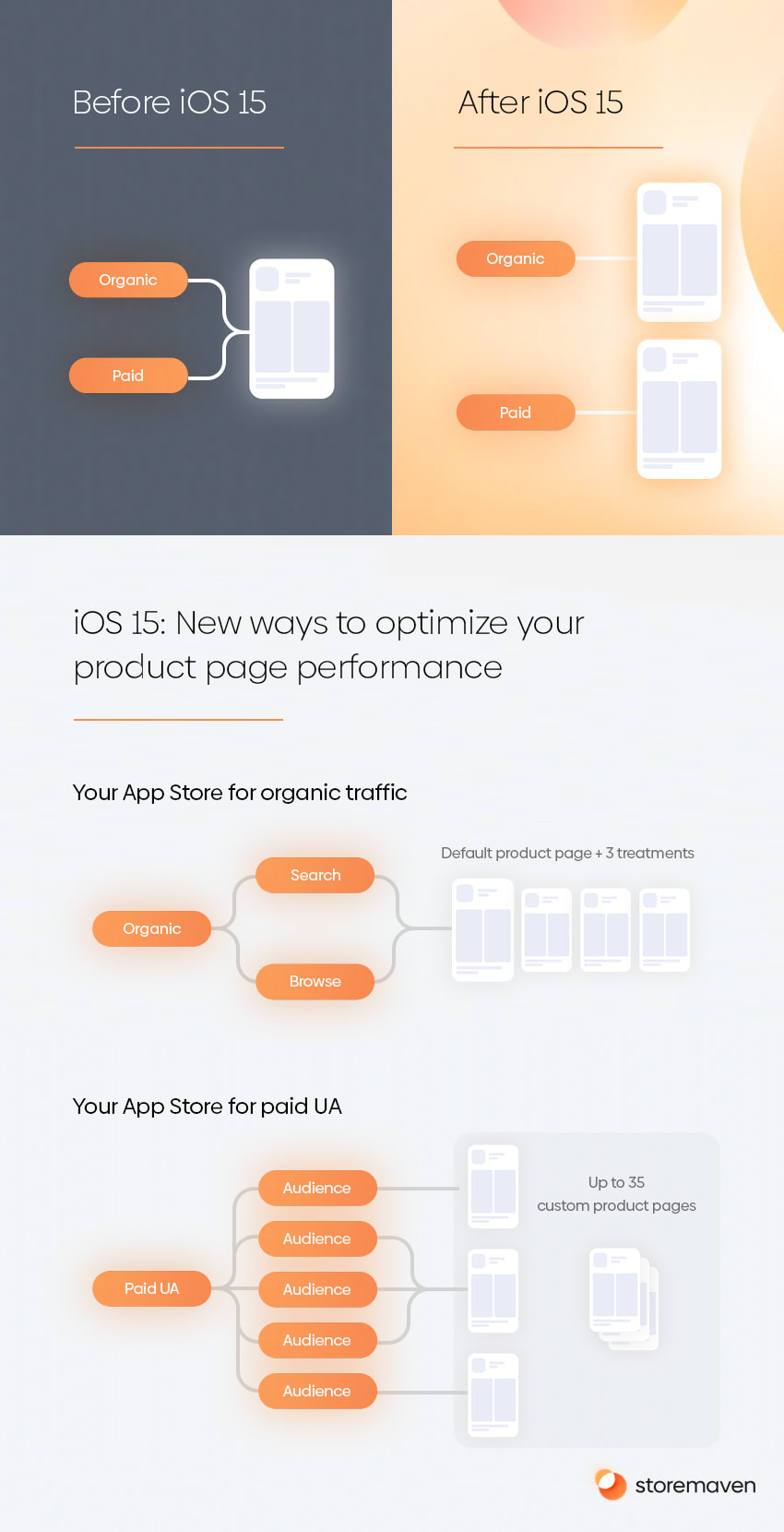
This means that if you work in ASO, UA, mobile marketing, or growth, you have a tremendous opportunity ahead of you to significantly increase your install growth rates by catering the right message to the right audience in iOS 15.
The flip side of this coin is that if you don’t adopt these technologies, your competitors will be able to “steal” your installs.
As the industry adopts these new App Store capabilities (and I talked with many developers that started prepping) your competitors are going to have a more efficient UA machine, driving paid installs through personalized funnels with product pages that match the messaging they see on the ads driving them to the App Store. Meanwhile, on the organic side they’ll have much more converting App Store product pages for users finding them through Browse (top charts, category charts, and featuring) as well as search (branded keywords and non branded keywords).
This means that when you’re competing with your competitors on the same audience and that audience finds both of your App Store product pages, your competitor will have a much better chance of converting traffic as they’ll have better messaging, personalized to the user source.
So I wrote this note as a guide for your iOS 15 App Store Optimization (ASO) and App Store Marketing to ensure you maximize paid and organic installs and kill it at your job.
iOS 15 ASO: Paid vs Organic
Any great ASO operation on iOS will be divided into:
- The paid app store, managed through what Apple has named Custom Product Pages (CPP).
You will have up to 35 custom product pages (CPPs) that you’ll be able to customize with their own app store preview videos, screenshots and promotional text for different audiences.
You’ll then be able to generate a unique App Store URL that’ll lead that audience from its source to that dedicated CPP (any paid UA campaign, website traffic, cross-promotion, influencer marketing campaigns, etc.).
If all your paid UA traffic will reach a certain CPP, that means that your default App Store product page will receive only organic traffic coming in by browsing the App Store (Browse traffic) or searching the App Store (Paid traffic).
- The organic app store, managed through what Apple has named Product Page Optimization (PPO).
For the default App Store product page, you’ll be able to run Product Page Optimization, or, Apple’s native a/b testing offering. You’ll be able to create up to 3 treatments (variations of your product page and test them against your existing control product page.
This test will run solely on organic traffic, allowing you to optimize your App Store product page conversion rates for organic traffic. Unfortunately, you won’t be able to have a dedicated product page for search traffic or one for browse traffic.
So what are you going to do with an App Store for your paid traffic with 35 custom product pages and one App Store for your organic traffic with one App Store product page you can test with four variations?
Thanks to the great experts here at Storemaven we were able to prepare for this moment and I’m excited to share with you the first iOS 15 framework that’ll allow you to:
- Understand the mechanics of ASO, and specifically creative optimization in iOS 15
- Organize your thoughts around how you should set up your processes, teams and goals post-iOS 15 – making order out of the chaos.
- Guide you towards a repeatable framework we developed to increase ROAS and install conversion rates for both paid and organic installs post-iOS 15.
How to optimize your paid App Store for iOS 15
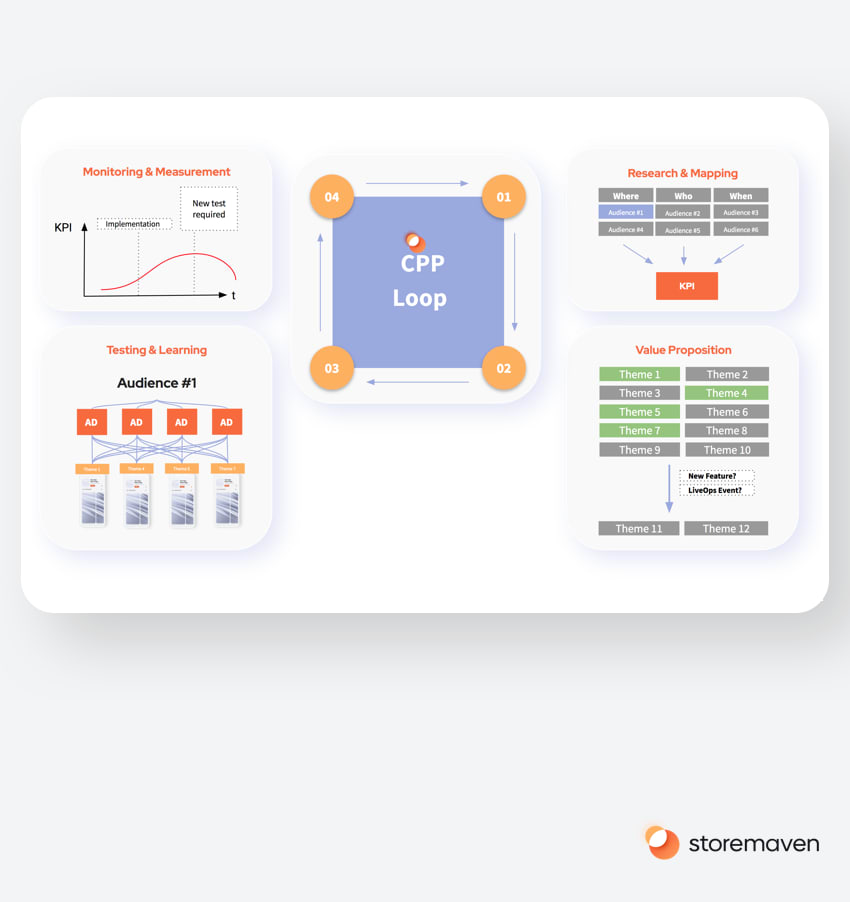
We broke down your paid App Store methodology into four main parts that make up a loop that could and should be iterated on ongoingly to drive further improvements and to avoid growth decay (the phenomenon where your messaging hasn’t been updated for too long and becomes outdated or less relevant for the audience and conversion rates start to erode).
Phase 1: Plan your App Store custom product pages (CPPs)
Before you even start, which product and geo you should start with? This is one of those questions where there will never be a one-size-fits-all solution. It depends on:
- Whether you are working in a multi-product company or a single product one.
- How global your marketing is, are you targeting the entire globe, or focused on a single country?
- Which market and product is more strategic for the company?
To go through this exercise you should start by mapping your current value generators. Ask yourself questions like:
- What does the company strategy value currently? Is the strategy to maximize market share and user base growth at the expense of revenues? Is it the opposite situation?
- Where does most of your UA budget is spent in terms of products and geos?
- What are the most valued KPIs at the moment? Is the team focused on user base growth at all costs or is there a specific new country or audience you’re trying to break into and reach?
All of these questions would dictate how you should prioritize the products you want to optimize for and in which market. There is no wrong answer here and this depends on the company’s strategy.
It could be fair to try to strengthen your weak spots or double down on your strong ones.
The most important thing though is to prioritize. With up to 35 custom product pages that can be localized, there are a lot of product pages to plan, design, test, and analyze, and it’ll take time, so make sure you start at the right place.
Phase 1a: Conduct Audience Research and mapping
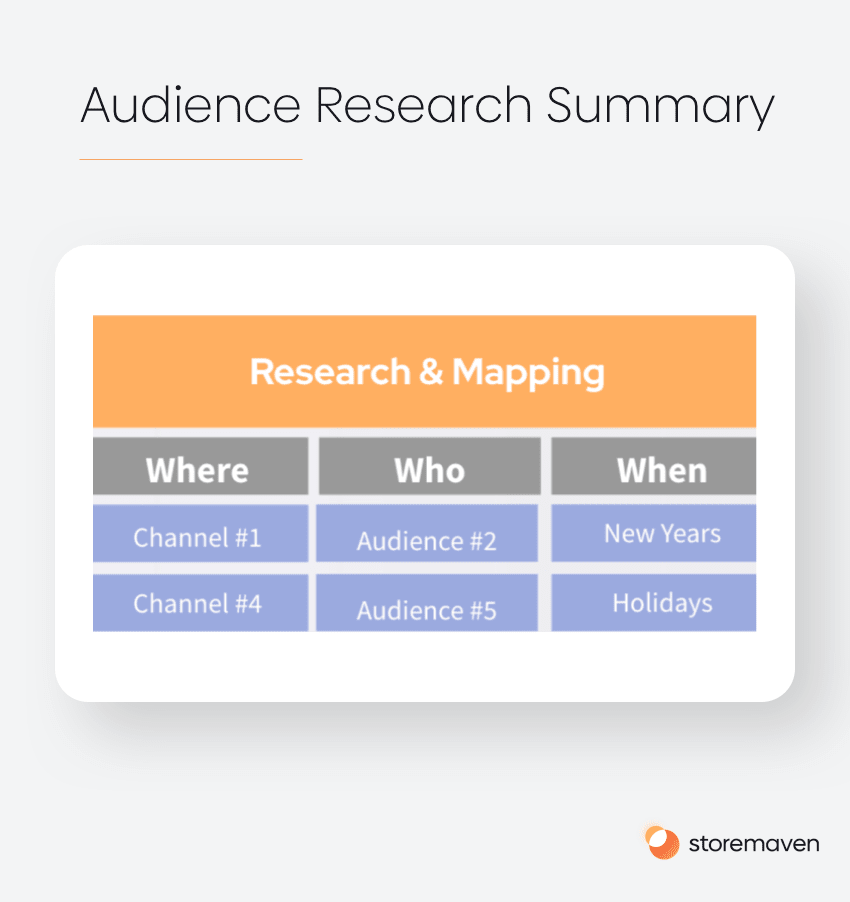
- Audience research
First of all, as marketers, we have to start with the audience.
Segment your paid traffic to audiences by asking yourself three questions:
- Where? Which channels are your paid users coming from? Sort the data from your most important channels to the least important ones.
- Who? What are the audience targeting profiles you’re using? Sort these from audience size from top bottom (Soccer moms, Young Professionals, Hardcore gamers, etc.).
- When? Last but not least, when are you spending most of your UA budget? Is it focused around certain events throughout the year? Seasons? i.e., if you are marketing a fitness app and a big chunk of your UA budget is spent around the time of new years’ resolutions, you should take that into consideration in your research.
Once you’re finished you should have a database comprised out of your top audiences, channels, and any specific time throughout the year that affects your UA ad creative messaging.
It could look something like this (for informational purposes only, this is an oversimplification of audiences but you should get the gist of it):
- Audience #1 – 25-34 males, young professionals, coming in from Facebook campaign #3 during the holiday season
- Audience #2 – 35-44 females, busy business owners, coming in from Tiktok campaign #1
- Audience #3 – 25-44, both genders, digital nomads, coming in from Snapchat campaign #2
Phase 1b: Map value proposition and conduct theme research
Now it’s time to start mapping out your value propositions to create alternative “themes” for your product page. After analyzing 500M users on the App Store we discovered that most users (up to 70%) make a decision after 3-6 seconds of glancing at your “first impression”.
A theme is comprised of a value proposition and a design style.
1. Value proposition
You probably know a lot about the main value propositions of your product.
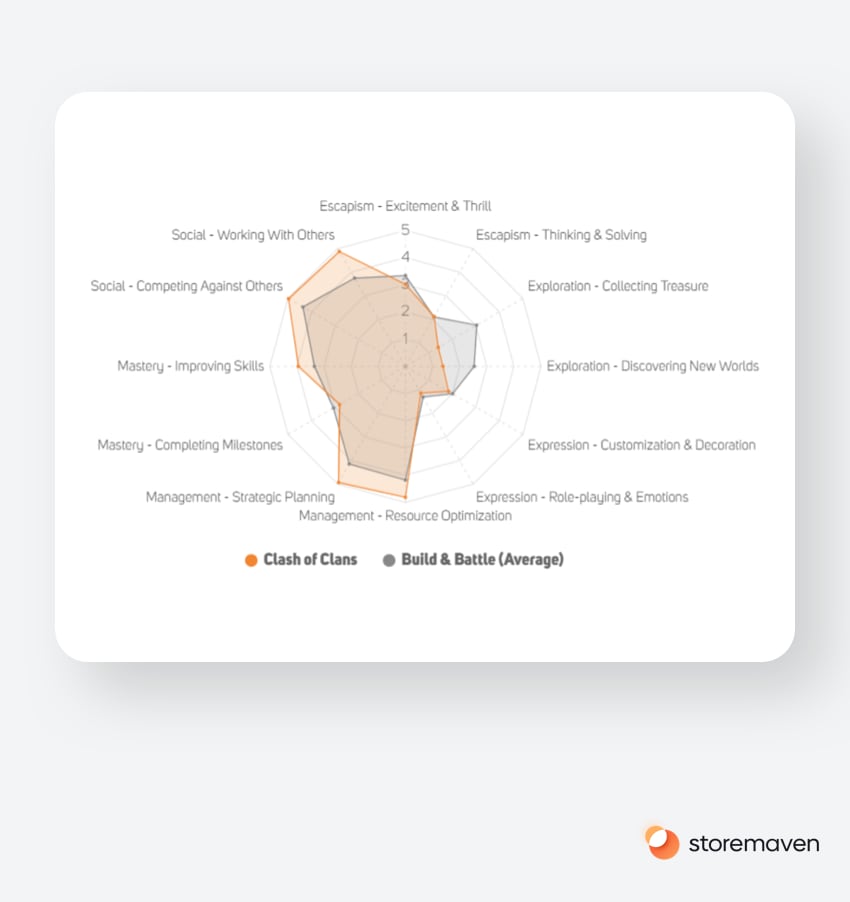
This example (by AppAgent) for Clash of Clans shows the main value proposition and motivators that the game is offering overlaid by the average for Build & Battle games.
During your research you should:
Internal Research
- Research your current users, how they use the app/game and what they value?
- Research your app/game reviews to identify common threads and gauge what your users value the most
- Which value propositions your best performing ads are using?
External Research
- Research your category and examine the value propositions the most popular apps/games in the category are promoting through their product pages.
Once you finished mapping a comprehensive list of your most valued value propositions that might look something like this:

2. Design style
For each value proposition, there are multiple ways to convey it to your App Store paid audience by using different design styles (some examples below):
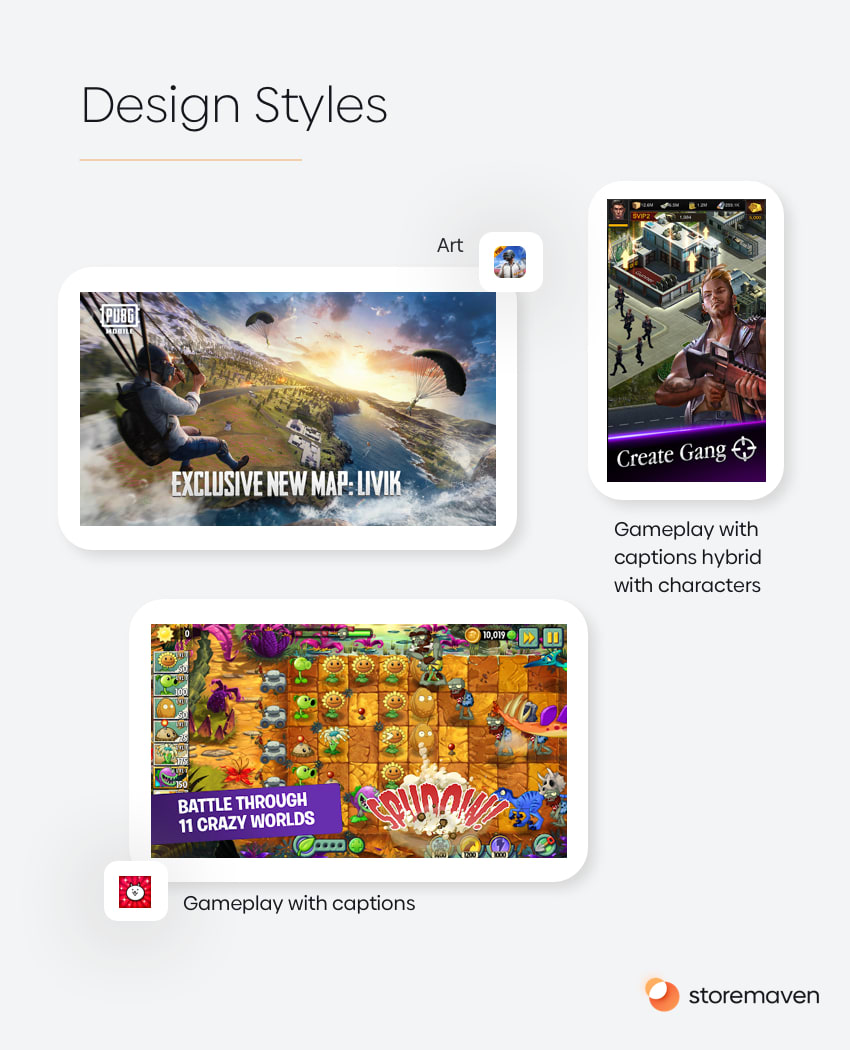
Internal Research
- Research your top performing ads, which design styles are they using?
External Research
- Research your category’s most popular apps/games, which design trends they are using in their ads and in their App Store product pages?
When you finish this stage, you should end up with a theme matrix, composed out of your value proposition on one axis, and design styles on the other which should generate many different ideas.
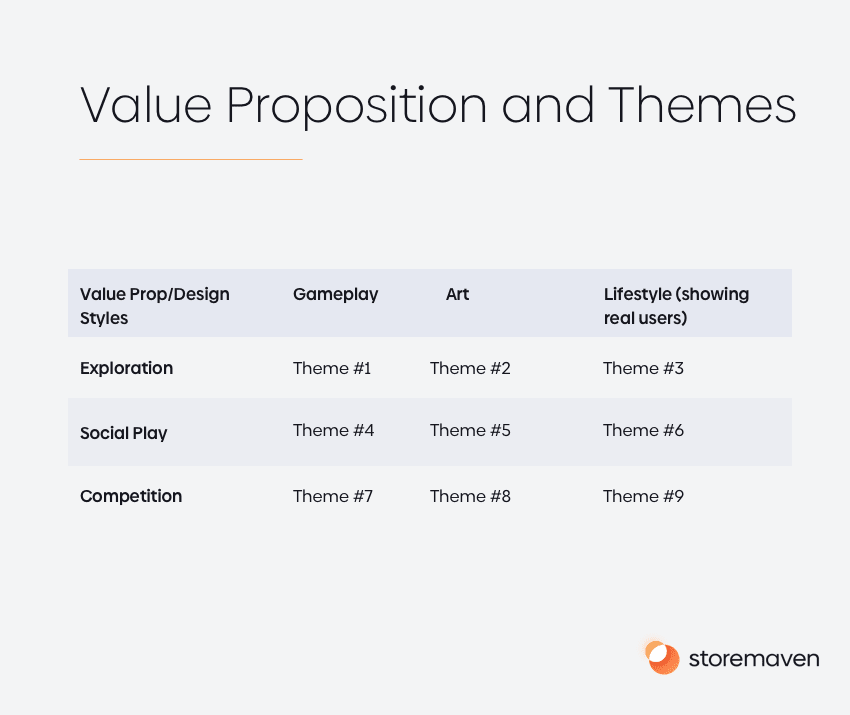
Phase 1c: Develop hypotheses
Here’s the fun part. Now you should, based on the research you did, the audiences, the value propositions and the design styles you listed and prioritized start developing hypotheses.
To develop a hypothesis starts with the audience segment you want to focus on, based on your priorities, and examine the value propositions you listed.
Hypotheses are beliefs you are trying to prove or disprove. Which value proposition should be optimal for an audience segment?
Value proposition hypotheses
A hypothesis might look something like this:
“The hardcore gamers FB segment would be more likely to install by seeing a product page with a “open world” theme”.
It could compete with a hypothesis that says:
“The hardcore gamers FB segment would be more likely to install by seeing a product page with a “character development” theme”.
Design style hypotheses
Hypotheses can also be beliefs about the optimal design style to convey a certain value proposition. For example;
“The hardcore gamers FB segment would be more likely to install by seeing a product page with a “open world” value proposition with a gameplay design style, showing the open world within a device frame”.
Which might compete with:
“The hardcore gamers FB segment would be more likely to install by seeing a product page with a “open world” value proposition with an art design style, showing the open world with beautiful 3D art rendering”.
List your top hypotheses for your top audiences, and you’ll have a summary of test hypotheses. Remember to first test broad value propositions and once you found a value proposition that worked well you could further test the design style that fits that value proposition the best.
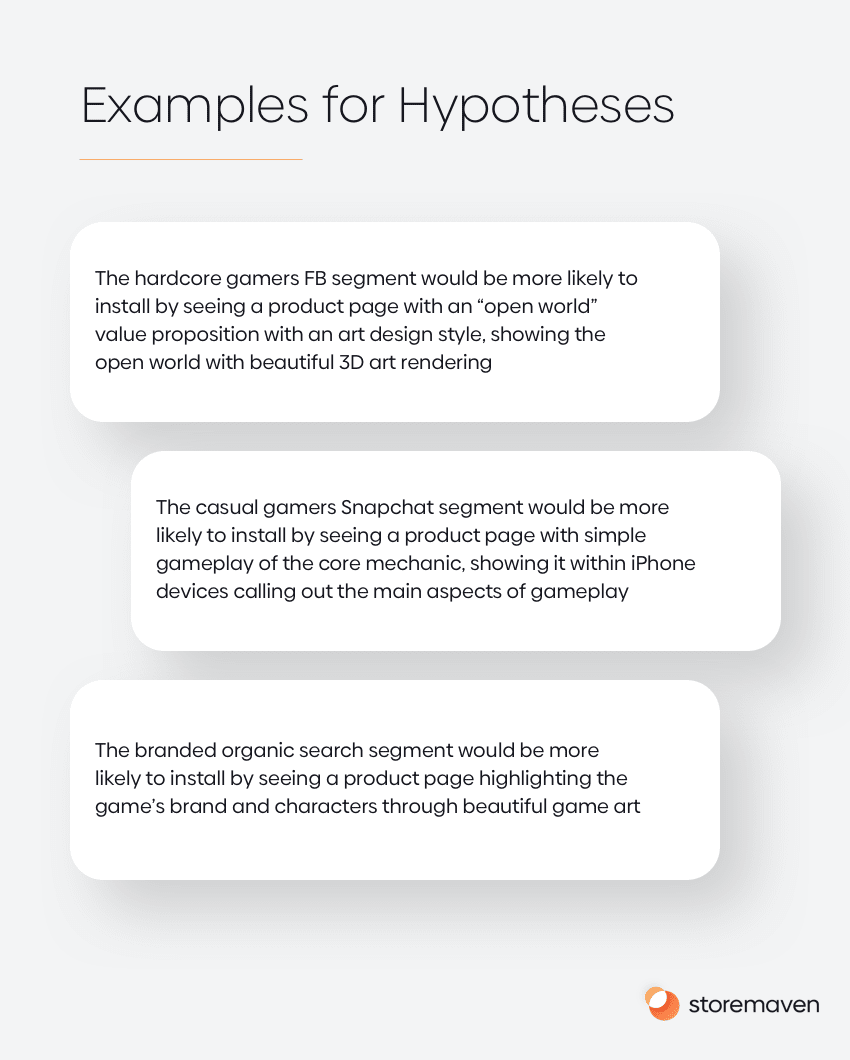
Phase 1d: Design your product page
Your toolbox for custom product pages contains an app preview video, screenshots and promotional text. Based on our research, app preview videos and screenshots would be x10 more effective to convey your themes/value propositions than the promotional text (Our research showed users are significantly more likely to respond to visual elements than text ones).
Now you need to translate your hypotheses to product pages using the customizable assets.
Here are a few examples of how different hypotheses might look like on a product page. To read more about how to translate hypotheses into designs you can read this guide here.
Phase 2: Test and analyze
Once you have several CPPs designed to test a certain hypothesis you can start to run your tests.
You will be able to test CPPs using Storemaven by driving relevant ad campaign traffic (let’s say FB hardcore gamers) to multiple CPPs, each testing a different hypothesis for that audience.
During the test we will randomly distribute traffic to each CPP and will measure the conversion rates, retention and ARPPU for each CPP and calculate the statistical significance of the test up until our Bayesian model, StoreIQ, will determine that a certain CPP is the winner.
During this test, the test users reaching the pages can, in fact, install the app as this is the actual App Store environment.
Once you found a winner you can apply it by directing all traffic to the winning variation, and enjoy the lift in conversion rates and install for that paid audience segment.
Phase 3: Monitor and analyze
After the winner was applied for the entire audience segment, you should monitor over time the ROAS, conversion rates, retention and ARPPU of the CPP to identify:
- The lift you were able to achieve (as only that audience segment will reach the CPP there is minimal noise that would interrupt you from analyzing the impact).
- The point in time in which your CPP will start experiencing conversion rate decay as it wasn’t updated for an extended period of time, which should alert you to get back to testing.
Once you’re done with a certain test you should get back to phase 1 (Research and planning) and update your beliefs and document them (FB hardcore games prefer the open-world value proposition).
You should then move to either further optimize performance for the same audience segment or choose the next top priority audience to optimize the CPP for.
Several tests can be run at once. For a certain localization given you have 35 custom product pages you can run 8 tests at once, each with 4 variations testing different hypotheses.
Once you identify the right variation for a certain audience you can use the CPP slots you used for testing for that audience for further testing for other audiences.
Summary: iOS 15 Guide Takeaways
This complete guide for iSO 15 app store optimization provides you with the general framework for optimizing your paid app store traffic. Every time you go through the loop you should reassess your assumptions. Your audience preferences might have changed, a new competitor using a different design style or offering a new value proposition might have emerged, or your product team has released a new feature that allows you to test a new value proposition.
Your liveops team might have been preparing a new in-app event that you could leverage to create another value proposition.
CPP optimization is extremely dynamic, but following this robust process, you’ll always be on top of which audience segment should be served with each CPP to maximize conversion rates, retention, and ROAS.
Over time, you’ll generate a database of all your learnings and you’ll be able to direct your UA spend towards the right audiences and the right CPPs to drive growth.
—-
If all of this sounds tough to manage, don’t worry, Storemaven has developed the world’s first Growth Intelligence platform to manage the entire CPP optimization loop, you can request early access here.












